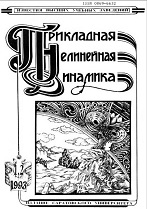|
This article is cited in 1 scientific paper (total in 1 paper)
MODELING OF GLOBAL PROCESSES. NONLINEAR DYNAMICS AND HUMANITIES
Nonlinear elite generation change model
A. V. Kolesnikova, G. G. Malinetskiib, A. V. Podlazovb, S. N. Sirenkoc
a Institute of Philosophy of the National Academy of Sciences of Belarus, Minsk, Republic of Belarus
b Keldysh Institute of Applied Mathematics, Moscow, Russia
c Maksim Tank Belarusian State Pedagogical University, Minsk, Republic of Belarus
Abstract:
The purpose of the presented article was to build a concise conceptual mathematical model of the competitive dynamics of alternative types of social activity. The model was developed in the form of a discrete two-dimensional non-linear mapping. The proposed mapping is new and has not been previously studied either in the field of mathematical social dynamics (sociophysics), or in the section of discrete models of nonlinear dynamics. The approach we used corresponds to the ideas of the theory of social time put forward by F. Braudel. Nonlinear two-dimensional mapping, in a paradoxical way, given the general socio-economic ideas about the relationship between generations, as it turned out, has a Hamiltonian structure. The analysis showed that both formally and in terms of qualitative behavior it is close to the standard model describing a rotator under the action of impacts. It was found that, depending not only on the parameters of the problem, but also on the initial conditions, in this case, periodic, quasiperiodic, and chaotic dynamics are simultaneously possible. Within the framework of the model, this means a great variety of intergenerational relationships. Thus, the data in the system will not be "forgotten". The influence on the dynamics of the model of "dissipative additions" describing the degradation of the elite, the desire of society to "eliminate the best" is demonstrated. The dynamics of the system and its dependence on parameters become much simpler; nevertheless, cyclicity and multistability do not disappear in it. In this approximation, history turns out to be "local" the details and peculiarities of society's behavior will be "forgotten" after several generations. The study of the constructed model opens up great prospects for the analysis of various types of cyclical processes in mathematical history.
Keywords:
modeling of social processes, mathematical history, social dynamics, two-dimensional maps, Hamiltonian dynamics, generational conflict, Dynamic chaos, space man, sensitivity to parameters and initial data, historical time.
Received: 27.12.2021
Citation:
A. V. Kolesnikov, G. G. Malinetskii, A. V. Podlazov, S. N. Sirenko, “Nonlinear elite generation change model”, Izvestiya VUZ. Applied Nonlinear Dynamics, 30:4 (2022), 456–479
Linking options:
https://www.mathnet.ru/eng/ivp490 https://www.mathnet.ru/eng/ivp/v30/i4/p456
|

|




 Contact us:
Contact us: Terms of Use
Terms of Use
 Registration to the website
Registration to the website Logotypes
Logotypes








 Citation in format
Citation in format 
